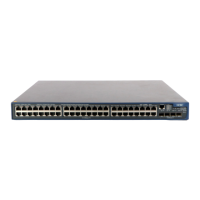1-41
├-(P_0/28)<-->(P_3/0/1)[Sysname:000f-e200-1774]
|
├-(P_0/22)<-->(P_1/0/2)[aaa_5.H3C:000f-e200-5111]
|
├-(P_0/18)<-->(P_3/0/2)[Sysname S3600:000f-e218-d0d0]
|
├-(P_0/14)<-->(P_1/0/2)[Sysname:000f-e200-5601]
|
└-(P_0/4)<-->(P_0/2)[S3600-28P-SI:000f-e200-00cc]
The output information of the display cluster base-topology command is in the following format:
(peer port number)<-->(local port number)[peer device name:peer device MAC address]
For example, (P_0/40)<-->(P_0/6)[Sysname:000f-e200-2200] means that the peer device uses its port
Ethernet 1/0/40 to connect to port Ethernet 1/0/6 of the local device; the peer device name is Sysname;
the MAC address of the peer device is 000f-e200-2200.
display cluster black-list
Syntax
display cluster black-list
View
Any view
Parameters
None
Description
Use the display cluster black-list command to display the information of devices in the current cluster
blacklist.
Related commands: black-list.
Examples
# Display the contents of the current cluster blacklist.
<aaa_0.Sysname> display cluster black-list
Device ID Access Device ID Access port
000f-e200-5502 000f-e202-2180 Ethernet1/0/24
00e0-fd34-bc66 000f-e202-2180 Ethernet1/0/1
Table 1-11 Description on the fields of the display cluster black-list command
Field Description
Device ID
ID of the device in the blacklist, expressed by the MAC address of
the device
Access Device ID
ID of the device (in the cluster) that is connected with a device in
the blacklist, expressed by the MAC address of the device
Access port Port (in the cluster) that is connected with a device in the blacklist

